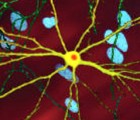Diffusion tensor imaging (DTI) has shown microstructural abnormalities in patients with Huntington’s Disease (HD) and work is underway to characterise how these abnormalities change with disease progression. Using methods that will be applied in longitudinal research, we sought to establish the reliability of DTI in early HD patients and controls. Test-retest reliability, quantified using the intraclass correlation coefficient (ICC), was assessed using region-of-interest (ROI)-based white matter atlas and voxelwise approaches on repeat scan data from 22 participants (10 early HD, 12 controls). T1 data was used to generate further ROIs for analysis in a reduced sample of 18 participants. The results suggest that fractional anisotropy (FA) and other diffusivity metrics are generally highly reliable, with ICCs indicating considerably lower within-subject compared to between-subject variability in both HD patients and controls. Where ICC was low, particularly for the diffusivity measures in the caudate and putamen, this was partly influenced by outliers. The analysis suggests that the specific DTI methods used here are appropriate for cross-sectional research in HD, and give confidence that they can also be applied longitudinally, although this requires further investigation. An important caveat for DTI studies is that test-retest reliability may not be evenly distributed throughout the brain whereby highly anisotropic white matter regions tended to show lower relative within-subject variability than other white or grey matter regions.
Huntington’s disease is a neurodegenerative disorder caused by mutations in the CAG tract of huntingtin. Several studies in HD cellular and rodent systems have identified disturbances in cyclic nucleotide signaling, which might be relevant to pathogenesis and therapeutic intervention. To investigate whether selective phosphodiesterase (PDE) inhibitors can improve some aspects of disease pathogenesis in HD models, we have systematically evaluated the effects of a variety of cAMP and cGMP selective PDE inhibitors in various HD models. Here we present the lack of effect in a variety of endpoints of the PDE subtype selective inhibitor SCH-51866, a PDE1/5 inhibitor, in the R6/2 mouse model of HD, after chronic oral dosing.
Striatal neuronal degeneration and loss is an important feature of human Huntington’s disease (HD). R6/2 HD mice recapitulate many features of human HD including striatal atrophy. While striatal neuronal atrophy and loss is reported in R6/2 HD mice the degree of neuronal loss and the characteristics of cell body atrophy are unclear. We used stereological approaches to estimate whole striatal neuronal numbers and characterize changes in striatal neuronal size distribution. R6/2 HD mice had ~126000 fewer neurons per striatum (~12% decline) at 12 weeks of age than wild-type litter-mates; differences were not present at 5 weeks. Analysis of striatal neuronal numbers per cell body size category revealed declines in neuron numbers in the size ranges 550-1050 µm3 suggesting that larger striatal neurons are more susceptible to atrophy or loss in late stages of disease. R6/2 HD mice have a striatal neuronal loss phenotype. As striatal neuronal loss in human HD is dramatic, neuronal loss in R6/2 striatum provides an important late-stage outcome measure for study of disease modifying interventions
Huntington’s disease (HD) is an inherited neurodegenerative disorder caused by a CAG repeat expansion in the huntingtin (HTT) gene. Both central and peripheral innate immune activation have been described as features of the disease. Isolated human HD monocytes have been shown to produce more cytokines upon LPS stimulation compared to control monocytes. Understanding alterations in the signalling cascades responsible and activated by this increase in pro-inflammatory cytokine production is crucial in understanding the molecular basis of this phenomenon. Here we investigated the signalling cascade most commonly activated by pro-inflammatory cytokines such as IL-6 – the JAK/STAT signalling cascade. Using flow cytometry, we show that one out of three key transcription factors activated by JAK/STAT signalling is altered in primary human HD innate immune cells, suggesting that this pathway may only play a minor, additive role in the immune cell dysfunction in HD.
Huntington’s disease (HD), a devastating neurodegenerative disorder caused by a CAG repeat expansion on the HTT gene located on chromosome 4, is associated with a characteristic pattern of progressive cognitive dysfunction known to involve early deficits in executive function. A modified Go/No-go successive discrimination task was designed to assess the type of online response control/executive function known to be disrupted in patients with HD. The present studies show that this simple discrimination assay revealed early and robust deficits in two mouse models of HD, the zQ175 KI mouse (deficits from 28 weeks of age) and the R6/2 mouse, carrying ~240 CAG repeats (deficits from 9 weeks of age). These deficits are not due to gross motor dysfunction in the test animals, but instead appear to measure some inability to inhibit responding in the HD mouse models, suggesting this assay may measure deficits in underlying attentional and/or behavioral inhibition processes. Accordingly, this assay may be well suited to evaluation of simple deficits in cognitive function in mouse HD models, providing a potential platform for preclinical screening.
Objective: To assess the effects of an intensive, multidisciplinary rehabilitation program for patients with early to mid-stage Huntington’s disease.
Design: A prospective intervention study.
Setting: Two Norwegian inpatient rehabilitation centers.
Subjects: 37 patients, with early- to midstage Huntington’s disease
Interventions: A one year rehabilitation program, consisting of three admissions of three weeks each, and a five-day evaluation stay approximately 3 months after the last rehabilitation admission. Focus was on physical exercise, social activities, and group/teaching sessions. There was also emphasis to implement of coordinated health care and social services for the patients.
Main outcome measures: standard measures for motor function, including gait and balance, cognitive function, including MMSE and UHDRS cognitive assessment, anxiety and depression, activities of daily living (ADL), health related quality of life and Body Mass Index (BMI).
Results: Significant improvements were observed in gait function, balance, in physical quality of life, anxiety and depression, as well as in BMI. ADL-function remained stable with no significant decline. Only one cognitive measure (SDMT) showed significant decline, while no decline was observed for the remaining cognitive measures.
Conclusion: A multidisciplinary intensive rehabilitation program in patients with early and mid stage HD is associated with improved balance, gait function, physical quality of life and with reduced depressive and anxiety symptoms. Longer follow-up is needed to assess if these positive effects are sustained. There should be emphasis to establishment of long term and coordinated health care services for the HD patient
The genome of the Bacterial Artificial Chromosome (BAC) transgenic mouse model of Huntington’s Disease (BAC HD) contains the 170 kb human HTT locus modified by the addition of exon 1 with 97 mixed CAA-CAG repeats. BAC HD mice present robust behavioral deficits in both the open field and the accelerating rotarod tests, two standard behavioral assays of motor function. BAC HD mice, however, also typically present significantly increased body weights relative to wildtype littermate controls (WT) which potentially confounds the interpretation of any motor deficits associated directly with the effects of mutant huntingtin. In order to evaluate this possible confound of body weight, we directly compared the performance of BAC HD and WT female mice under food restricted versus free feeding conditions in both the open field and rotarod tasks to test the hypothesis that some of the motor deficits observed in this HTT-transgenic mouse line results solely from increased body weight. Our results suggest that the rotarod deficit exhibited by BAC HD mice is modulated by both body weight and non-body weight factors resulting from overexpression of full length mutant Htt. When body weights of WT and BAC HD transgenic mice were normalized using restricted feeding, the deficits exhibited by BAC HD mice on the rotarod task were less marked, but were still significant. Since the rotarod deficit between WT and BAC HD mice is attenuated when body weight is normalized by food restriction, utilization of this task in BAC HD mice during pre-clinical evaluation must be powered accordingly and results carefully considered as therapeutic benefit can result from decreased overall body weight and or motoric improvement that may not be related to body mass. Furthermore, after controlling for body weight differences, the hypoactive phenotype displayed by ad libitum fed BAC HD mice in the open field assay was not observed in the BAC HD mice undergoing food restriction. These findings suggest that assessment of spontaneous locomotor activity, as measured in the open field test, may not be the appropriate behavioral endpoint to evaluate the BAC HD mouse during preclinical evaluation since it appears that the apparent hypoactive phenotype in this model is driven primarily by body weight differences.
Phenotyping with traditional behavioral assays constitutes a major bottleneck in the primary screening, characterization, and validation of genetic mouse models of disease, leading to downstream delays in drug discovery efforts. We present a novel and comprehensive one-stop approach to phenotyping, the PhenoCube™. This system simultaneously captures the cognitive performance, motor activity, and circadian patterns of group-housed mice by use of home-cage operant conditioning modules (IntelliCage) and custom-built computer vision software. We evaluated two different mouse models of Huntington’s Disease (HD), the R6/2 and the BACHD in the PhenoCube™ system. Our results demonstrated that this system can efficiently capture and track alterations in both cognitive performance and locomotor activity patterns associated with these disease models. This work extends our prior demonstration that PhenoCube™ can characterize circadian dysfunction in BACHD mice and shows that this system, with the experimental protocols used, is a sensitive and efficient tool for a first pass high-throughput screening of mouse disease models in general and mouse models of neurodegeneration in particular.
While there has been a guideline for laboratory/genetic diagnosis of Huntington Disease (HD) since 1998, no such statement exists for the diagnosis of clinical HD. Informally, the most frequently used criteria for diagnosis of clinical HD is ‘Motor 4’ within the Unified Huntington Disease Rating Scale ’99 (motor), made when the rater is highly confident that ‘motor abnormalities observed are unequivocal signs of HD’. Recent studies involving pre-manifest individuals illustrated the shortcomings of this motor-only diagnostic approach. For instance, PREDICT-HD found cognitive changes decades before the expected date of motor diagnosis. Using a number of case studies, we highlight some of the subtleties involved in diagnosing clinical HD, in the absence of unequivocal motor signs for HD. New, broader, criteria for the diagnosis of clinical HD would be helpful in many ways. However its formulation will need to flexible rather than prescriptive, and will require extensive consultation with clinicians and families with HD.
Metabolic dysfunction and mitochondrial involvement are recognised as part of the pathology in Huntington’s Disease (HD). Post-mortem examinations of the striatum from end-stage HD patients have shown a decrease in the in vitro activity of complexes II, III and IV of the electron transport system (ETS). In different models of HD, evidence of enzyme defects have been reported in complex II and complex IV using enzyme assays. However, such assays are highly variable and results have been inconsistent.
We investigated the integrated ETS function ex vivo using a sensitive high-resolution respirometric (HRR) method. The O2 flux in a whole-cell sample combined with the addition of mitochondrial substrates, uncouplers and inhibitors enabled us to accurately quantitate the function of individual mitochondrial complexes in intact mitochondria, while retaining mitochondrial regulation and compensatory mechanisms.
We used HRR to examine the mitochondrial function in striata from 12-week old R6/2 mice expressing exon 1 of human HTT with 130 CAG repeats. A significant reduction in complex II and complex IV flux control ratios was found in the R6/2 mouse striatum at 12 weeks of age compared to controls, confirming previous findings obtained with spectrophotometric enzyme assays.



